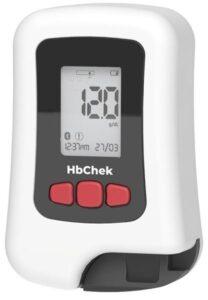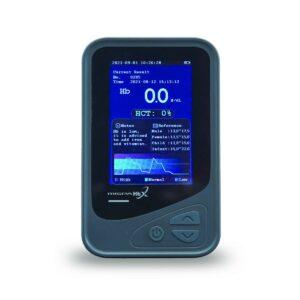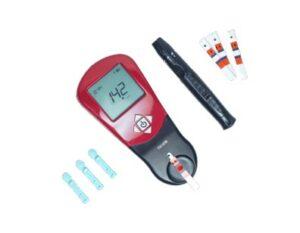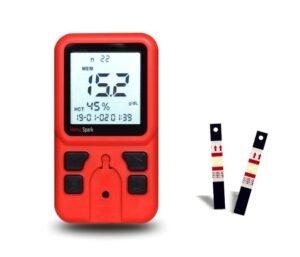Hemoglobin Meters play a vital role in measuring and monitoring hemoglobin levels, providing crucial insights into an individual’s health. Whether you’re a healthcare professional or an individual looking to take control of your well-being, understanding the fundamentals of Hemoglobin Meters is essential. But before we embark on this enlightening journey, it’s important to highlight a revolutionary B2B platform called Medzell. Medzell is paving the way for Indian medical device manufacturers to promote their cutting-edge products in emerging markets. With its futuristic approach, Medzell aims to bridge the gap between healthcare providers and innovative Indian medical devices, empowering healthcare professionals worldwide with advanced tools for enhanced patient care.
Now, let’s dive into the world of Hemoglobin Meters and unlock the key to better healthcare decisions.
Exploring Hemoglobin Measurement Technology
In the realm of medical technology, Hemoglobin Meters have emerged as a groundbreaking tool for measuring hemoglobin levels in our blood. These devices utilize advanced measurement technologies that provide accurate and reliable results, contributing to improved healthcare outcomes. Let’s explore some of the key technologies used in Hemoglobin Meters and understand their significance in the medical industry. By analyzing the specific wavelengths of light absorbed, Hemoglobin Meters can determine the hemoglobin concentration. Spectrophotometric Hemoglobin Meters are known for their high accuracy and precision, making them a popular choice in clinical settings.
Another innovative technology used in Hemoglobin Meters is electrochemical analysis. This method involves the use of electrodes to measure the electrical properties of the blood sample. Electrochemical Hemoglobin Meters offer fast and reliable results, making them suitable for point-of-care testing and home use. These devices are particularly beneficial in remote or resource-limited areas where access to laboratory facilities may be limited. Non-invasive optical sensing is yet another cutting-edge technology employed in some Hemoglobin Meters. By shining light onto the skin or through the fingertip, these devices can measure the absorption and reflection of light to estimate hemoglobin levels. Non-invasive Hemoglobin Meters are convenient and painless, providing a user-friendly option for frequent monitoring without the need for blood sampling.
A Comprehensive Guide to Hemoglobin Testing
Hemoglobin testing plays a crucial role in diagnosing and managing various medical conditions. In this blog, we will explore the different methods of hemoglobin testing and their significance in the medical industry. One of the most common methods of hemoglobin testing is laboratory-based analysis. In the lab, various techniques such as spectrophotometry or automated cell counters are employed to measure hemoglobin levels accurately. Laboratory-based testing provides highly accurate results and is often used for diagnostic purposes and monitoring chronic conditions.
POCT devices, including portable Hemoglobin Meters, provide rapid results, enabling healthcare professionals to make immediate treatment decisions. POCT is particularly valuable in emergencies or when real-time monitoring is required. Portable Hemoglobin Meters have gained popularity due to their convenience and ease of use. These handheld devices offer quick and reliable results, making them suitable for use in remote or resource-limited settings. They are especially beneficial in areas where access to laboratory facilities is limited, allowing for timely diagnosis and monitoring.
Hemoglobin testing is of utmost importance in managing various medical conditions. For instance, in the early detection of anemia, hemoglobin testing helps identify low hemoglobin levels and determine the underlying cause. Regular monitoring of hemoglobin levels is also crucial for individuals with chronic conditions like diabetes or sickle cell disease, as it aids in disease management and treatment optimization.
Comparing the Best Hemoglobin Meters
With advancements in technology, a wide range of hemoglobin meters are available in the market today. In this section, we will compare some of the top hemoglobin meters currently available, taking into account their key features, performance, and user reviews. By understanding the strengths and limitations of different hemoglobin meters, healthcare professionals can make informed decisions and choose the most suitable option for their specific needs.
One important aspect to consider is the measurement technology used by each hemoglobin meter. Some meters utilize spectrophotometry, which involves analyzing the absorption of light by hemoglobin to measure its concentration. Others employ electrochemical analysis, where a chemical reaction between hemoglobin and electrodes produces an electrical signal that correlates with hemoglobin levels. Non-invasive optical sensing is another approach that allows for pain-free and quick measurements, often using infrared light to assess hemoglobin levels.
Beyond the measurement technology, factors such as ease of operation, sample size requirements, measurement time, and data storage capabilities should be evaluated. Some hemoglobin meters offer additional features like wireless connectivity for seamless data transfer, integration with electronic health records, and compatibility with mobile applications for tracking and analysis.
By comparing the best hemoglobin meters in terms of accuracy, ease of use, and additional features, healthcare professionals can confidently select a device that meets their requirements and enhances patient care.
Uncovering the Benefits of Hemoglobin Meters
Hemoglobin meters offer numerous benefits that contribute to improved healthcare outcomes and patient management. Let’s explore the advantages of using hemoglobin meter in various healthcare settings.
- Quick and Convenient Measurements: Haemoglobin meters provide rapid results, allowing healthcare professionals to obtain hemoglobin levels in a matter of minutes. This speed is particularly beneficial in emergencies or when frequent monitoring is required.
- Point-of-Care Testing: Portable hemoglobin meters enable point-of-care testing, eliminating the need for sending samples to a laboratory for analysis. This saves time and resources, enabling prompt decision-making and immediate initiation of treatment.
- Accurate and Reliable Results: Hemoglobin meters employ advanced technologies that ensure accurate and reliable measurements. This precision is essential for making accurate diagnoses, monitoring treatment progress, and adjusting therapeutic interventions as necessary.
- Non-Invasive Testing Options: Some hemoglobin meters utilize non-invasive techniques, such as optical sensing, which eliminates the need for blood draws. This offers a painless and convenient testing experience, particularly for pediatric patients or individuals with a fear of needles.
- Efficient Anemia Detection and Monitoring: Haemoglobin meters are invaluable tools for detecting and monitoring anemia. They enable healthcare professionals to identify anemia early, determine its severity, and track changes in hemoglobin levels over time.
- Enhanced Diabetes Management: Hemoglobin meters play a crucial role in diabetes management by measuring glycated hemoglobin (HbA1c) levels.
- Sickle Cell Disease Monitoring: Haemoglobin meters are essential in monitoring hemoglobin levels and detecting complications in individuals with sickle cell disease. Regular monitoring allows healthcare professionals to intervene promptly and prevent severe complications.
- Improved Patient Engagement: Haemoglobin meters empower individuals to actively participate in their healthcare by providing immediate access to their hemoglobin levels.
Maintaining and Caring for Hemoglobin Meters
To ensure the accuracy and reliability of hemoglobin meter measurements, it is essential to properly maintain and care for these devices. Regular maintenance and adherence to specific guidelines can help prolong the lifespan of the meter, minimize the risk of contamination, and ensure consistent performance.
Here are some essential tips for maintaining and caring for hemoglobin meter.
- Calibration and Quality Control: Regularly calibrate the hemoglobin meter according to the manufacturer’s instructions to maintain accuracy. Perform routine quality control checks using control solutions provided by the manufacturer to verify that the meter is functioning correctly.
- Cleaning and Disinfection: Clean the meter after each use using a lint-free cloth and a mild detergent or disinfectant recommended by the manufacturer. Ensure proper disinfection to prevent cross-contamination between patients.
- Storage Conditions: Follow the manufacturer’s recommendations for proper storage conditions, including temperature and humidity ranges.
- Battery Management:To ensure uninterrupted operation, it is recommended to regularly monitor the battery status of the hemoglobin meter and replace them as necessary if it is battery-powered. It is also advisable to have spare batteries readily available.
- Regular Inspection: Regularly inspect the hemoglobin meter to verify the condition of its components. Promptly address any signs of wear or damage that are identified during the inspection.
- User Training and Education: Provide proper training to healthcare professionals who will be using the hemoglobin meter. Ensure that they are familiar with the operating instructions, maintenance procedures, and troubleshooting techniques.
By following these maintenance guidelines, healthcare professionals can maximize the lifespan of the hemoglobin meter and ensure the accuracy and reliability of the measurements. Regular maintenance and proper care contribute to consistent performance and help healthcare providers deliver high-quality patient care.
Detecting Anemia with Haemoglobin Meters
Early detection and monitoring of anemia are essential for timely intervention and effective management. Hemoglobin meters play a crucial role in detecting anemia by providing quick and accurate measurements of hemoglobin levels. Hemoglobin meters offer several advantages in detecting anemia:
- Rapid Results: Hemoglobin meters provide immediate results, allowing for prompt identification of individuals with low hemoglobin levels, indicative of anemia.
- Point-of-Care Testing: Portable hemoglobin meters enable point-of-care testing, allowing healthcare professionals to assess hemoglobin levels conveniently and quickly, without the need for sending samples to a laboratory.
- Accuracy and Reliability: Hemoglobin meters employ advanced measurement technologies that ensure accurate and reliable results. This precision is crucial in detecting and monitoring anemia effectively.
- Patient Engagement: Hemoglobin meters empower individuals to actively participate in their healthcare by providing immediate access to their hemoglobin levels. This promotes awareness and understanding of their condition, fostering patient engagement in the management of anemia.
By utilizing hemoglobin meter for detecting anemia, healthcare professionals can promptly identify individuals at risk, initiate appropriate interventions, and ensure optimal management of this prevalent medical condition.
Monitoring Sickle Cell Disease with Hemoglobin Meters
Monitoring hemoglobin levels and other parameters related to sickle cell disease is crucial for detecting complications, assessing disease severity, and guiding appropriate interventions. Hemoglobin meters play a vital role in the monitoring and management of sickle cell disease.
- Haemoglobin Level Monitoring: Hemoglobin meters allow healthcare professionals to accurately measure hemoglobin levels, which can fluctuate in individuals with sickle cell disease. Regular monitoring helps identify trends and deviations from the baseline, enabling timely intervention.
- Oxygen Saturation Monitoring: Some advanced hemoglobin meters incorporate oxygen saturation monitoring capabilities. This is particularly beneficial for individuals with sickle cell disease, as it helps assess tissue oxygenation and detect potential complications, such as acute chest syndrome.
- Non-Invasive Testing Options: Non-invasive optical sensing technology used in certain hemoglobin meters allows for painless and quick measurements. This is especially advantageous for individuals with sickle cell disease, as frequent blood draws can be both physically and emotionally challenging.
- Timely Intervention: Regular monitoring of hemoglobin levels using hemoglobin meters enables healthcare professionals to detect and address complications associated with sickle cell disease promptly. Early intervention helps prevent severe complications and improve overall disease management.
- Patient Empowerment: Hemoglobin meters provide individuals with sickle cell disease access to their hemoglobin levels, fostering patient empowerment and engagement. This enables individuals to actively participate in their healthcare, understand their condition better, and make informed decisions regarding self-management.
The Future of Hemoglobin Meters
The field of hemoglobin meters is continuously evolving, driven by advancements in technology and the ever-increasing demand for accurate and convenient diagnostic tools. The future of hemoglobin meters holds exciting possibilities and potential developments that will further enhance healthcare practices and patient care.
Here are some potential advancements in hemoglobin meter technology and their impact on healthcare in the future:
- Miniaturization and Portability: Hemoglobin meters are likely to become even more compact and portable, enabling point-of-care testing in various healthcare settings.
- Non-Invasive Techniques: These techniques, such as optical sensing or spectroscopy, aim to eliminate the need for blood draws and provide painless and quick measurements, enhancing patient comfort and compliance.
- Integration with Digital Health Platforms: Future hemoglobin meters may seamlessly integrate with digital health platforms, electronic health records, and mobile applications.
- Advanced-Data Analysis: With the increasing emphasis on data-driven healthcare, future hemoglobin meters are likely to incorporate advanced data analysis algorithms.
- Connectivity and Interoperability: Hemoglobin meters may feature enhanced connectivity options, allowing for seamless data transmission and interoperability with other healthcare devices and systems.
- Artificial Intelligence and Machine Learning: The integration of artificial intelligence and machine learning algorithms into hemoglobin meters holds significant potential.
The future of hemoglobin meter is promising, with advancements focused on miniaturization, non-invasive techniques, digital integration, advanced data analysis, connectivity, and the incorporation of artificial intelligence. These developments will revolutionize hemoglobin testing, improve patient outcomes, and contribute to the overall advancement of healthcare practices.
Hemoglobin Meters From Leading Indian Manufacturers
Hbchek
 Hbchek, manufactured by Tulip Diagnostics (P) Ltd, is a cutting-edge hemoglobin meter that stands among the leading devices in India’s healthcare industry. Utilizing transmittance/absorbance spectrophotometry, Hbchek offers a gold standard point-of-care hemoglobin testing experience. Its microfluidic technology ensures precise results with high accuracy, indicated by a CV (Coefficient of Variation) of less than 3% when compared to the gold standard method. Designed for ease of use, Hbchek requires minimal maintenance and offers Bluetooth connectivity, allowing seamless integration with a mobile application. The device features a large LCD display, enabling easy result visualization, and can store up to 1000 results, ensuring efficient data management. With its reliable performance and advanced technology, Hbchek provides healthcare professionals and individuals with dependable tools for accurate hemoglobin measurements.
Hbchek, manufactured by Tulip Diagnostics (P) Ltd, is a cutting-edge hemoglobin meter that stands among the leading devices in India’s healthcare industry. Utilizing transmittance/absorbance spectrophotometry, Hbchek offers a gold standard point-of-care hemoglobin testing experience. Its microfluidic technology ensures precise results with high accuracy, indicated by a CV (Coefficient of Variation) of less than 3% when compared to the gold standard method. Designed for ease of use, Hbchek requires minimal maintenance and offers Bluetooth connectivity, allowing seamless integration with a mobile application. The device features a large LCD display, enabling easy result visualization, and can store up to 1000 results, ensuring efficient data management. With its reliable performance and advanced technology, Hbchek provides healthcare professionals and individuals with dependable tools for accurate hemoglobin measurements.
Mispa HbX
 Agappe Diagnostics Limited, a leading manufacturer and supplier of medical devices, presents Mispa HbX, a portable hemoglobin analyzer designed to deliver accurate and high-quality results in the shortest possible time. Incorporating Spectrophotometry Scattered Compensation technology, Mispa HbX ensures precise measurements by compensating for scattering effects. This innovative approach guarantees reliable outcomes within 3 seconds of sample reading initiation. Mispa HbX is remarkably convenient to use, requiring only 7 µl of blood for analysis. Its three-step procedure enhances usability, streamlining the testing process. With a CV value of less than 1.5% and microfluidic cuvettes boasting a shelf life of 2 years, Mispa HbX offers long-lasting and reliable performance. The device also provides a 6-hour battery backup, making it a portable and handheld equipment option for healthcare professionals on the go.
Agappe Diagnostics Limited, a leading manufacturer and supplier of medical devices, presents Mispa HbX, a portable hemoglobin analyzer designed to deliver accurate and high-quality results in the shortest possible time. Incorporating Spectrophotometry Scattered Compensation technology, Mispa HbX ensures precise measurements by compensating for scattering effects. This innovative approach guarantees reliable outcomes within 3 seconds of sample reading initiation. Mispa HbX is remarkably convenient to use, requiring only 7 µl of blood for analysis. Its three-step procedure enhances usability, streamlining the testing process. With a CV value of less than 1.5% and microfluidic cuvettes boasting a shelf life of 2 years, Mispa HbX offers long-lasting and reliable performance. The device also provides a 6-hour battery backup, making it a portable and handheld equipment option for healthcare professionals on the go.
HEMA 2
Kanad Vidyut, a leading manufacturer and supplier of hemoglobin meters in India, presents HEMA 2, a state-of-the-art device that offers direct hemoglobin and glucose results. HEMA 2 utilizes two primary methods: Drabkins or A.H.D and End Point by Standard. The device features multiple modes, including Test (Hb/Glu), Calibration, and Absorbance, allowing flexibility in measurement settings. One of the notable features of HEMA 2 is its auto calculation of Calibration factors, streamlining the calibration process for enhanced efficiency. The device also allows numeric entry of known Hb or Glucose standards for calibration mode, ensuring accuracy in measurements. HEMA 2 is a reliable tool for healthcare professionals, offering precise and direct results for both hemoglobin and glucose analysis.
TrueHb
 Wrig Nanosystems Private Limited, a leading manufacturer and supplier of hemoglobin meters in India, presents TrueHb, an accurate home-use device for measuring hemoglobin levels. TrueHb employs reflectance photometry technology to quantitatively measure hemoglobin concentration in the blood. By applying a blood drop to the TrueHb hemometer strip, hemoglobin is extracted from the red blood cells and converted into a complex with the reagents present in the strip. The optical reflectance is measured, providing a reliable indication of hemoglobin concentration. TrueHb is not only suitable for in vitro diagnosis by healthcare professionals but also enables individuals to monitor their own wellness. It proves especially valuable in monitoring the development of fetuses in pregnant women and serves as an indicator for chronic kidney disease among individuals with diabetes and hypertension. The TrueHb hemometer strips, with their thin plastic design and integrated chemical reagents, provide accurate and easy-to-use measurement capabilities for hemoglobin levels.
Wrig Nanosystems Private Limited, a leading manufacturer and supplier of hemoglobin meters in India, presents TrueHb, an accurate home-use device for measuring hemoglobin levels. TrueHb employs reflectance photometry technology to quantitatively measure hemoglobin concentration in the blood. By applying a blood drop to the TrueHb hemometer strip, hemoglobin is extracted from the red blood cells and converted into a complex with the reagents present in the strip. The optical reflectance is measured, providing a reliable indication of hemoglobin concentration. TrueHb is not only suitable for in vitro diagnosis by healthcare professionals but also enables individuals to monitor their own wellness. It proves especially valuable in monitoring the development of fetuses in pregnant women and serves as an indicator for chronic kidney disease among individuals with diabetes and hypertension. The TrueHb hemometer strips, with their thin plastic design and integrated chemical reagents, provide accurate and easy-to-use measurement capabilities for hemoglobin levels.
Hemo Spark
 Sensa Core Medical Instrumentation Pvt. Ltd., a prominent manufacturer, and supplier of hemoglobin meters in India, introduces Hemo Spark, an in vitro diagnostic device for measuring total hemoglobin levels in the blood. Hemo Spark stands out as one of the most portable and affordable hemoglobin meters, offering user-friendly operation and reliable results. It utilizes reflectance photometry technology to determine the hemoglobin content, ensuring accuracy in measurements. Hemo Spark is particularly valuable in areas where clinical laboratories may not be readily accessible, thanks to its ease of use and ability to deliver quick results. It also proves useful in emergencies due to its accuracy and rapid response time. Hemo Spark meets global standards for accuracy, reproducibility, and specificity, guaranteeing dependable results that healthcare professionals can rely on.
Sensa Core Medical Instrumentation Pvt. Ltd., a prominent manufacturer, and supplier of hemoglobin meters in India, introduces Hemo Spark, an in vitro diagnostic device for measuring total hemoglobin levels in the blood. Hemo Spark stands out as one of the most portable and affordable hemoglobin meters, offering user-friendly operation and reliable results. It utilizes reflectance photometry technology to determine the hemoglobin content, ensuring accuracy in measurements. Hemo Spark is particularly valuable in areas where clinical laboratories may not be readily accessible, thanks to its ease of use and ability to deliver quick results. It also proves useful in emergencies due to its accuracy and rapid response time. Hemo Spark meets global standards for accuracy, reproducibility, and specificity, guaranteeing dependable results that healthcare professionals can rely on.
Conclusion
In conclusion, Hemoglobin Meters are powerful tools that provide valuable insights into our health by measuring and analyzing hemoglobin levels. With their accuracy, convenience, and ability to diagnose and monitor various medical conditions, Hemoglobin Meters have become indispensable in modern healthcare. By utilizing Hemoglobin Meters, individuals can take control of their well-being, detect anemia early, effectively manage diabetes, and monitor conditions like Sickle Cell Disease. Furthermore, it is essential to properly maintain and care for Hemoglobin Meters to ensure their optimal performance and longevity. Regular maintenance and adherence to manufacturer guidelines can help achieve accurate results and extend the lifespan of these devices. As we look to the future, the field of Hemoglobin Meter technology holds great promise.


